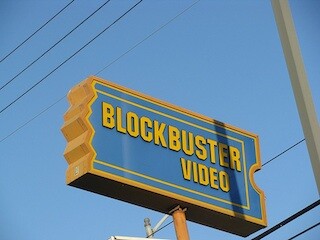Truth matters. Community matters. Your support makes both possible. LAist is one of the few places where news remains independent and free from political and corporate influence. Stand up for truth and for LAist. Make your year-end tax-deductible gift now.
A History Of Strikes: How The WGA Has Played Catch-Up As Emerging Technologies Made Others Richer

Stories are timeless. The way they get to us — not so much.
As we moved through the millennia, from hearing tales around a campfire to hearing them around a smart speaker, the creators of those stories are usually forgotten. And the same has often been the case since the advent of movies, then television, then streaming: Writers might have been the engine of their success, but they are often marginalized when it comes to credit and compensation.
The earliest incarnation of the Writers Guild of America, formed more than a century ago, was organized around basic conceits that remain true today. As was written by the guild’s forebears in 1920, those goals included “fair screen and advertising credits for writers, and adequate compensation and royalties.”
When screenwriters first started organizing in the early 20th century, it was not uncommon for studio chiefs to give screenplay credits to mistresses. While that practice is long gone, writers would argue the vestiges of that kind of treatment remains today, especially as media companies try to keep profits from new technologies to themselves.

As those distribution platforms have evolved over the decades, allowing us to consume stories in a multitude of ways, writers have had to scramble to make sure they keep what they consider a rightful share of the revenues their stories generate. And the only path to do so is through collective bargaining, in talks held every three years or so that define payment and employment terms in what is known as the Minimum Basic Agreement.
It’s no surprise, then, that the Writers Guild of America is Hollywood’s most militant guild, having called for more strikes than any other industry union. Since 1960, the WGA has been on strike six times, more than all the other Hollywood guilds combined, almost always with some sort of paradigm shift at the center.
The current strike is just the latest example: With the runaway success of streaming, the union is asking for higher payments and residuals, and higher payments for streaming series that are popular. (They have their eye on artificial intelligence as well, asking for a commitment from the Alliance of Motion Pictures and Television Producers that they won’t use AI to replace writers.)
Here’s a chronology of the guild’s strikes over technology and distribution platforms — and what they achieved.
1981: 24-hour pay television channels
In 1981, when broadcast TV was still king, Showtime and HBO both launched 24-hour schedules. While pay television was still nascent, writers wanted to establish compensation tied to its emergence. The guild went on strike for 13 weeks. Ultimately the union got an agreement for the reuse of television programs on basic cable channels to be changed from fixed residuals to 1.2% of distributor's gross receipts, according to the WGA.
1985: Videocassettes

In 1985, the first Blockbuster Video store opened in Texas, and the chain eventually expanded to more than 9,000 outlets. That year, with videocassette sales booming, the WGA tried to negotiate for a larger share of home video residuals.
The strike lasted for just two weeks, after internal opposition. The ultimate deal — with WGA members getting a fraction of a fraction (0.3%, to be exact) of gross receipts — is still considered a fiasco, and cost writers potential billions in lost earnings.

1988: International markets
By 1988, international markets started growing rapidly as foreign demand for U.S. blockbusters surged. In 1987, The Lost World: Jurassic Park grossed $389.5 million overseas; 2015’s Jurassic World grossed more than $1 billion outside the United States. The WGA wanted a share of that for its writers.
It also wanted a larger piece of TV shows sold to basic cable networks. It went on strike for 22 weeks (the longest in guild history), and after protracted legal wranglings, ultimately negotiated higher residuals for reuse of TV content, creative rights over content and an audit program with the Directors Guild and SAG to make sure residuals are paid accurately.
2007: The internet
By 2007 it was clear “new media” would vastly expand. Six years earlier, the WGA had negotiated its first residuals tied to Internet use of films and television content made originally for other platforms, but the numbers were low. Now they were asking for more.
The WGA went on strike for 100 days, ultimately achieving payments for work made exclusively for new media, as well as residuals for digital downloads and work shown on ad-supported internet services.
2023: Streaming
Fifteen years later, it’s no longer digital downloads that are the issue, as much as the billions being made by streaming subscriptions. Writers want higher residuals than they're currently getting, and to be rewarded for working on top, successful shows (streamers don’t generally release their ratings, so it’s hard to know what's doing well). This strike sets out to change at least some of that.







